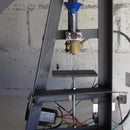Introduction: Super Oxygenated Multiponics
I'm using several hydroponic variants in one system, namely LP aeroponics( low pressure), DWC (deep water culture) bubbleponics and a modified circulating system derived from rDWC (recirculating deep water culture). I've also increased the water surface area to aid oxygen transfer.
The following pages will document my reservoir only, there isn't any top feeding or dripper systems etc.
I've added a structured water device recently and cant say how much it has contributed to overall growth, more about that later.
Step 1: Back to the Roots
I'm a great fan of "as above so below" where it applies to the plant root zone, meaning that the more roots you have, the greater foliage you can support which will in turn support/feed more fruit sites. The only time you should be cutting roots is if they're blocking intake, outlets, submersible pumps or you're working on your bonsai plant.
One of the better aspects of hydroponics versus soil growing, is that you can observe any problems in the root zone long before they create corresponding indications in the leaf structure.
- The first photo is a typical example of a massive DWC root zone, note how the higher "rope" roots support the lower feeding root mass, but don't seem to actually feed themselves as evidenced by a lack of lateral root growth. Spaghetti roots form the majority of the root structure and are typical of a submerged root system.
- The second photo is a fine example of TAG( true aeroponics growing), with lateral root development over the entire root zone. The fine hairs on the lateral roots indicate that they have been misted using a high pressure system. This aeroponic method was used by NASA in their space feeding program experiments and further refined by advanced aeroponic growers as evidenced by many users on the various cannabis growing forums.
- The last 2 photos are of my root zone. It can be seen that both the submerged roots and higher aerial roots have advanced lateral root development (herringbone roots).
This would seem to suggest that the entire root zone receives a good balance of water and oxygen mix, regardless of whether they are being sprayed intermittently above surface by the LP system or submerged in the circulating oxygenated water/nutrient mix.
Step 2: My Setup
I'm using:
- A Marina 200 Air pump, with dual outlets, on a 90cm long air curtain which also has dual connections at either end. It pumps 90L air per hour from each outlet.
- A 28Watt 1400Lph mag drive submersible pump for my LP aeroponic system. It drives 3 lighthouse microjets, the red top spins and with 5 jets, some of them weren't spinning, hence the 2 blanking plugs. It has an on time of 5 seconds and an off time of 4 minutes via a DIY repeat cycle timer which I found at
- A 6.5watt 400Lph mag drive submersible which is one of those really tiny table fountain models and pumps continuously doing duty as the circulation system.
- The output of the small submersible is connected to the structured water gadget, the stu (structured water unit) has been a very recent addition.
- 2 LECA (lightweight expanded clay aggregate) oxygenating walls fed via 10 3mm holes from the continuous circulation pump. I initially used pinholes in the LP tube but then wanted more circulation flow which would have degraded the microjets performance.
- Increased surface area for oxygen transfer by the use of floating LECA pellets.
In my opinion the bubble curtain creates a high humidity near the top of the reservoir for the aerial roots as well as introduce air into the res for oxygen transfer, and the LECA walls create the super oxygenated nutrient mix for the submerged roots.
Step 3: The Oxygenators
These LECA filled walls were made using plastic garden fencing and veg net. I used hot melt glue to tack on the veg net as well as gluing together the fencing. Cable ties are used to keep the walls from bulging and as support for the lower frame legs.
I simply used 2 U shaped pieces to create the LECA container, however it can be seen that many more variations can be made, as well as easier, in the case of 2 nested cylinders in a round bucket style of hydroponics.
It is my opinion that these LECA oxygenating walls are the main reason for the increase in root growth as seen in the side by side comparison photos spanning 2 days.
Step 4: The Structured Water Gadget
I have included my structured water gadget simply because there exists a possibility that it has contributed to the accelerated root growth that I observed in 2 days.
The commercial unit was created by Clayton Nolte, some field and lab tests over at www.structuredwaterunit.com convinced me of the devices usefulness.
A Youtube user, TheRealVerbz2, has opened up one of the units and it seemed rather simple to duplicate.
I made use of plastic beads and hot melt glue, although the glue isn't ideal for submerged use. I had an eight inch length of pvc tube that connected my pump to the T piece, 48 beads (24 pairs) fitted well.
I added 2 pieces of copper wire as a grid type retainer at the bottom to prevent anything falling into the pump impeller.













